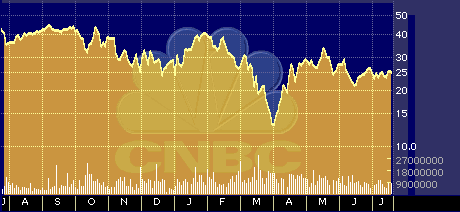
Why Analysts Like Flextronics
Why Analysts Like Flextronics
By Hal Plotkin
Silicon Valley Correspondent
If market watchers are right, electronic-manufacturing and service company Flextronics International Ltd.’s {FLEX} stock may soon see higher ground.
Several analysts reiterated or raised ambitious 12-month price targets on Flextronics’ stock last week, after a conference call led to upward revisions in revenue and earnings expectations for the company.
“Flextronics’ business is as good if not better than anyone else’s [in the sector],” says Louis Miscioscia, an analyst at Lehman Brothers in New York. “I think maybe there were some worries about their ability to integrate some acquisitions, but that doesn’t look like a problem now.”
Miscioscia raised his revenue and earnings forecasts for Flextronics’ fiscal second and third quarters, which end Sept. 30 and Dec. 31, respectively, after the company’s highly positive conference call last week.
The Lehman Brothers analyst also reiterated his $110 12-month price target and “1-buy” rating on the stock, his firm’s highest recommendation, saying that Flextronics’ executive team has consistently increased the guidance about upcoming quarters without any notable subsequent disappointments.

Flextronics International 52-Week Stock-Perfomance Chart
Miscioscia now sees Flextronics pulling in about $250 million more in revenue during the current fiscal second quarter than the $2.5 billion he had previously forecast. He says Flextronics should pile on another $450 million in fresh cash receipts in the next quarter, by which time he says the company will hit a quarterly run rate of about $3.2 billion, reflecting 95 percent year-over-year growth.
The analyst also raised his earnings-per-share estimates to 50 cents a share over the fiscal third quarter, up from 40 cents a share for the current quarter.
“I suspect everyone across the board raised their estimates after last week,” says Jim Savage, an analyst at Thomas Weisel Partners in New York. Savage upped his own 12-month price target on the stock, which he rates “strong buy,” to 114 from 100. The new price target is based, he says, on 50 times his projected calendar year 2001 earnings estimate for the firm.
Savage says Flextronics’ stock will likely be the beneficiary of a trickle-over effect if competing electronic manufacturing and service firm Jabil Circuit Inc. {JBL} reports strong quarterly results next Tuesday, Sept. 19.
Late Monday, another Flextronics competitor, Solectron Corp. {SLR}, reported fiscal fourth-quarter earnings for the three months ended Aug. 31, of 27 cents a share, a penny above expectations, and 10 cents above the net income the company posted in the year-earlier quarter.
Because it uses a different fiscal calendar Flextronics won’t report its official results for its current quarter until mid-October, which gives investors a bit more time to take further advantage of any traditional pre-earnings anticipatory run-up the stock might enjoy.
“Flextronics has consistently been beating estimates and raising guidance now for about the last two years,” Savage says. “I think the stock will get a near-term bounce over the next 10 days from the positive impact of Solectron and Jabil.”
A number of other analysts have also recently hopped on to the increasingly popular EMS bandwagon.
Last week, for example, Goldman Sachs analysts Michael Zimm and Amir Karim initiated coverage of 10 EMS stocks, including Flextronics, which received the firm’s highly coveted “recommended” designation.
The other EMS stocks added to Goldman Sachs’ “recommended” list are ACT Manufacturing Inc. {ACTM}, Celestica Inc. {CLS} and Jabil Circuit.
Six other EMS companies received an even more-enthusiastic “market ourperformer” rating from Goldman Sachs: Benchmark Electronics Inc. {BHE}, C-MAC Industries Inc. {EMS}, Plexus Corp. {PLXS}, Sanmina Corp. {SANM}, SCI Systems Inc. {SCI} and Solectron.
Overall, the analysts favor the cutting-edge role EMS firms play as high-volume makers of new generations of electronic products. They also say EMS companies are more immune than most firms to slowdowns or even downturns in the overall economy.
EMS companies manufacture and sometimes service products sold by brand-name firms. For instance, Flextronics’ customers include Cisco Systems Inc. {CSCO} and Ericsson {ERICY}.
Many of the companies started out in the PC or computer-assembly business but have since diversified operations to produce a wider range of electronic products, including high-end optical telecommunications and networking equipment. The companies’ diverse customer and product lists allow them to profitably participate in whatever segments of the high-tech industry are growing at any particular moment.
What’s more, EMS factories are often kept running around the clock, which maximizes efficiency in a way few if any single-product makers can hope to match.
“You have to remember that about 75 percent of EMS growth is due to greater outsourcing,” says J. Keith Dunne, an analyst at Robertson Stephens, based in San Francisco. “Only 25 percent is due to underlying growth in electronics markets.”
Dunne says that means the EMS companies can continue quite healthy growth rates into the foreseeable future, even in the unlikely event of an actual decline in the consumption or production of electronic goods.
“I don’t think we’re going to have a global recession,” Dunne says. “But even if we do, everyone is going to be hurt, but these companies would do better than most.” Bear Stearns analyst Thomas Hopkins, for example, expects a 40 percent to 50 percent upside for Flextronics stock before the end of the year.
“In general, this is a story that is counter-cyclical,” Savage says. “OEMs [original equipment manufacturers] tend to accelerate their outsourcing plans in periods when they have to worry about their end markets.”
“Over the next few years, we expect Flextronics’ to increase cash EPS by 35 percent to 40 percent annually on 40 percent to 50 percent revenue increases,” Dunne says. “We recommend the stock.”


